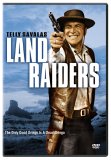| Reviews & Columns |
|
Reviews DVD TV on DVD Blu-ray 4K UHD International DVDs In Theaters Reviews by Studio Video Games Features Collector Series DVDs Easter Egg Database Interviews DVD Talk Radio Feature Articles Columns Anime Talk DVD Savant Horror DVDs The M.O.D. Squad Art House HD Talk Silent DVD
|
DVD Talk Forum |
|
|
| Resources |
|
DVD Price Search Customer Service #'s RCE Info Links |
|
Columns
|
|
|
Land Raiders
Savalas and Maharis are improbably cast as Hispanic Cain and Abel-like siblings, Savalas as Vince Carden, an immoral cattle baron with no regard for human life, and Maharis as his long-estranged brother Paul, a man haunted by the death of a lover some years before, a death many in his Arizona Territory hometown believe was murder.
Partly Land Raiders is a racial drama. Vince, born Vincente Cardenas, "becomes a gringo" in the eyes of younger brother Paul/Pablo. Vince has married a fair-skinned American woman (Arlene Dahl) and largely forsakes his Latin heritage, while Paul tries to reconnect with his ailing father (George Courlouris). The screenplay, by prolific television writer Ken Pettus, doesn't explore this with as much depth as he might, then again the performances of Savalas and Maharis are so at odds that it doesn't really matter. Maharis adopts a thick Spanish accent, but Telly Savalas pretty much plays Telly Savalas, New York accent and all. His performance is indistinguishable from, say, his Blofeld in On Her Majesty's Secret Service, filmed immediately before this but released after, or his latter-day Player's Club International commercials ("You listen to Telly, call Player's Club today!"). In his defense, Savalas' screen persona is at least engaging, something Maharis, for all his effort at characterization, is not.
The script's other story, also disjointed and underdeveloped, involves Vincent's fear-mongering to build upon his already vast cattle empire. Privately offering bounties on Apache scalps ($10 for men, $5 for woman, and $2.50 for children), Vincent deliberately aggravates tension between the Indians and the white folk, which he in turn uses to scare away settlers who sell their land at giveaway prices. In these scenes the film is moderately interesting for its amusing parallels to present-day fear-mongering on terrorism. Vince's big speech to the local townsfolk following an Apache attack he himself faked has startling similarities to current administration press briefings.
At the same time, the Apache are depicted as little more than inhuman savages and perhaps unintentionally live up to Vincent's warnings about them; it's hard to believe this was made at the same time as Arthur Penn's superb Little Big Man.
The picture was shot in Spain and Hungary with a few Spaniards in the cast (including busy Fernando Rey), and features an okay Spaghetti-style score by Bruno Nicolai, though most of the key cast and crew are either American or British. Director Nathan Juran had helmed several of Schneer-Harryhausen films, notably The 7th Voyage of Sinbad (1958) and First Men "in" the Moon (1964) before working almost exclusively for producer Irwin Allen, directing episodes of "Lost in Space," "Voyage to the Bottom of the Sea" and "The Time Tunnel." Land Raiders was his penultimate feature. As was typical for Juran, he doesn't rise above the material, but does a fine job considering what he had to work with. Stylistically, the film looks nothing at all like the Spaghetti Westerns Schneer probably hoped to imitate, with Juran's direction more akin to the good B-Westerns he made at Universal in the early-1950s - Law and Order, Tumbleweed (both 1953), Drums Across the River (1954) - albeit with more violence and flashes of nudity.
Despite an overuse of Vaseline-smeared flashbacks and lots of grainy stock footage from older Columbia movies for the lion's share of its action sequences (Mustang stampede, Indian attack on a stagecoach), there's a germ of a good movie in there somewhere; with a more polished script and a better cast and director, the blandly-titled Land Raiders might have been more memorable than it is.
Video & Audio
Shot for 1.85:1 cropping, Land Raiders is presented in a 16:9 enhanced transfer at 1.77:1. Except for the ugly, soft and splotchy title elements, the film is sharp and generally free of age-related wear, except for a yellowish line running through much of the first reel. The mono sound, accompanied by optional English and Japanese subtitles, is fine. There are no Extra Features.
Parting Thoughts
Land Raiders is for Western movie completests, Telly Savalas fans, and those interested in what producer Charles H. Schneer was up to when he wasn't working with Ray Harryhausen. It's not a bad movie, but neither is it anything more than bottom of the bill fodder.
Stuart Galbraith IV is a Kyoto-based film historian whose work includes The Emperor and the Wolf - The Lives and Films of Akira Kurosawa and Toshiro Mifune and Taschen's forthcoming Cinema Nippon. Visit Stuart's Cine Blogarama here.
|
| Popular Reviews |
| Sponsored Links |
|
|
| Sponsored Links |
|
|
| Release List | Reviews | Shop | Newsletter | Forum | DVD Giveaways | Blu-Ray | Advertise |
|
Copyright 2024 DVDTalk.com All Rights Reserved. Legal Info, Privacy Policy, Terms of Use,
Manage Preferences,
Your Privacy Choices | |||||||














